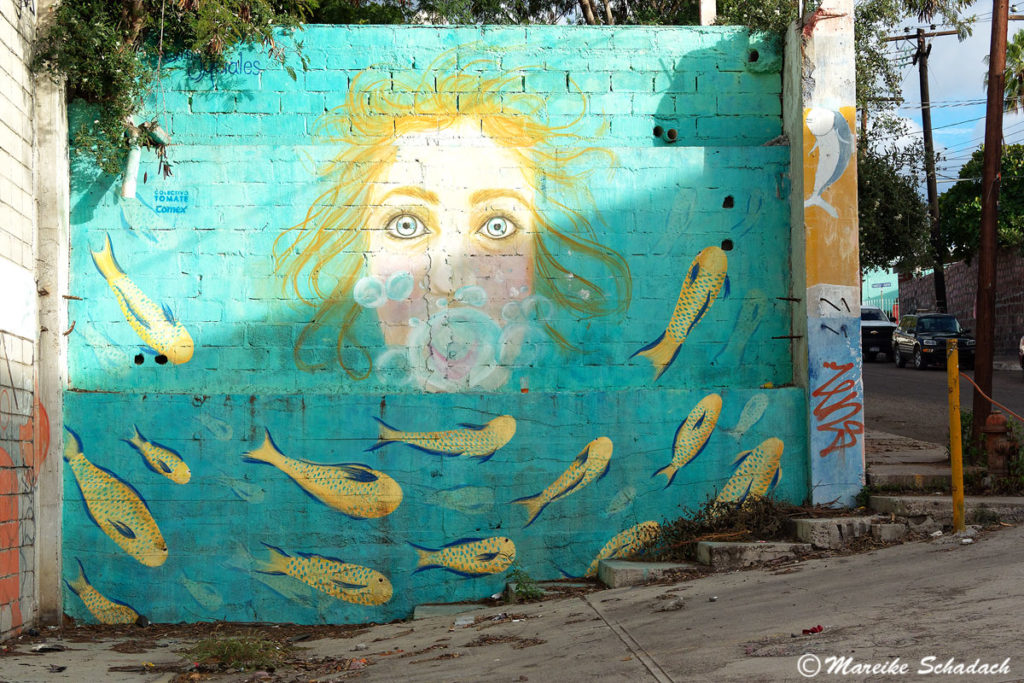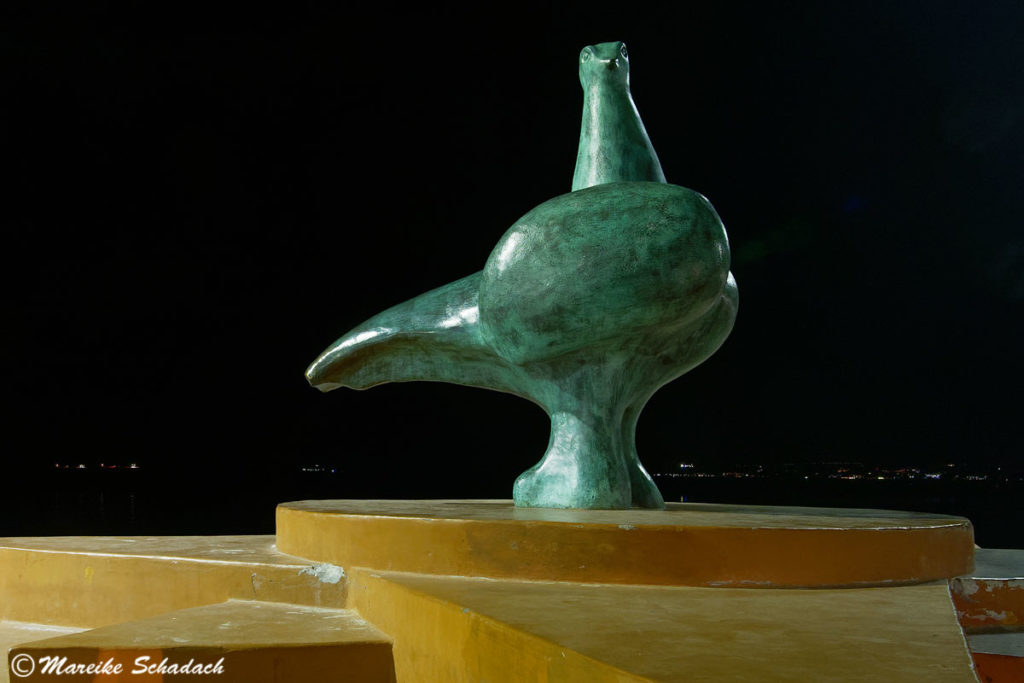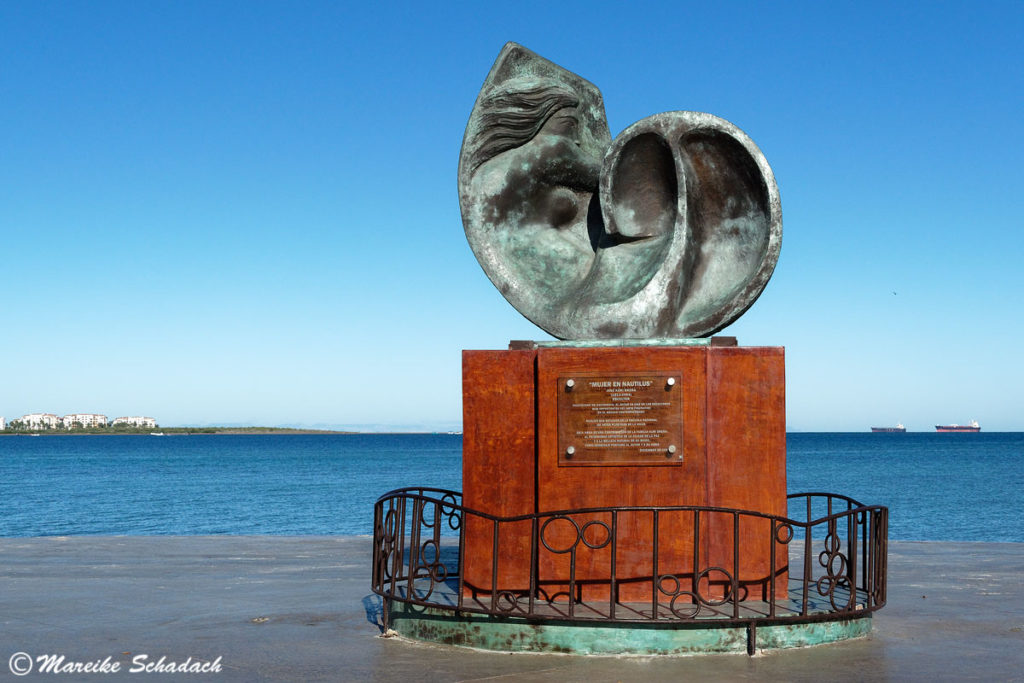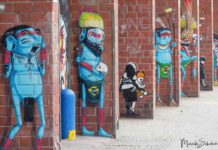Mexico. The colourful city of La Paz in Mexico invites you to explore. One of them starts directly at the Malecón, the magnificent waterfront promenade. A tour that holds some surprises in store: Street-art at its best. Murals and sculptures of whales, sharks and sea lions, a mermaid, the famous oceanographer Jacques Yves Cousteau and much more. They remind you of the history of the city and want to open your eyes for the beauty of the nature of Baja California. And they call for the protection of the seas. In my following article you will learn more about street art in La Paz, Mexico. You will get to know some of my favorite murals and sculptures and learn where you can discover them.
Nature connects
I knew the Baja California was famous for whale watching. But the fact that I got to see a blue whale took me by surprise. I have trouble capturing this huge animal with my camera. Luckily he holds still and I have a second try. Just in time I press the shutter release, then a red car slides between my camera and the whale.

The artist Dagos Art incorporates in his work elements such as flora, fauna and traditions characteristic of La Paz. He depicts these in ornaments inside the whale. He also divides the mural into two parts, the visible and invisible under water.
There are more whales in La Paz. They are joined by sea lions, sharks, dolphins and coyotes. The murals bring the fauna and flora of Baja California to the city. They want to connect people - among each other and with nature. They also want to shake people up, point out grievances and motivate them to be more environmentally aware.

A City becomes colorful - the Beginnings of Street Art in La Paz
It all began in 2013 in the Ignacio Zaragoza around the Big Sur Café. This is where the first murals of La Paz, Mexico, were created. An artist from Mexico City called the first street art competition. Thereupon several paintings were created in the Ignacio Zaragoza. In some of them several artists worked together. So it happens that some murals combine different styles.

This is where it all began. On the walls of the Big Sur Café in Ignacio Zaragoza a painting of an old woman's face with a hat was created in 2013. It was a joint project of several artists.

This elephant in the Ignacio Zaragoza was also created as a joint project. If you take a closer look, you will discover several faces, eyes and even a pregnant woman lying down in the elephant. In addition, the elephant holds a brush with its trunk. It is almost as if he had painted with it himself.
The Street-Art Project "Mural City La Paz"
In 2017 the artist collective Tomato Collective launched the project "Mural City La Paz". The historical center of La Paz became colorful. Inspired by the nature of the Baja California, 26 works of art were created. Artists and the people who live here painted together and created creative messages that call the value of nature to mind.
- 26 Artists
- 20 Volunteers
- 5 Workshops
- 26 Families
- 26 Murals
- 1350 Square Meters
Source: colectivo tomate
You can see about 50 murals in the city centre alone. Many works of art can be found in the streets Ignacio Zaragoza, A. Mijares, Melchor Ocampo, Mutualismo. On some murals there are even small signs with the name of the artist, the painting and a short description. You can discover the murals in La Paz on your own. But I liked a guided tour much better. By this way, one gets to know the most about the paintings and the interesting stories they tell.
Street-Art in the Street A. Mijares, La Paz

The mural "Convergencia Armonica" by Dherzu Uzala is inspired by the flora and fauna of La Palz. It shows the contrast that nature unites in one place: the desert and the sea. For Dherzu Uzala, the whale represents a peaceful, noble and magical being. At the same time, however, it is powerful and imposing. These characteristics describe the personality of the inhabitants of la Paz.

Beach, turquoise water, sea lions, birds and the sunsets over the bay of La Paz inspired Fando Criez to create this mural.

The painting by Eva Bracamonts shows two children in the centre of the picture. They hold a baby sea lion in their arms and a pearl shell in their hands. The fauna and flora of the Baja California grows around them. Everything is carried by a large turtle. In her work, the artist emphasizes the need to protect and preserve nature. Among other things, reference is made to the campaign for the protection of parrotfish, which was running at the time.

In the centre of the painting "The hook of yesterday and today" there is a fish, two hands and a hook. The fish represents the importance of fishing. The hook combines the left and the right side, representing the local and Iberian culture respectively. In the background you can see the fauna of Baja Califonia.
Street-Art in the Street Mutualismo, La Paz

The fishing is a basic activity of the inhabitants of La Paz. It does not only provide the people with food but it determines the whole economy and culture. The artist shows in her painting the "Reconcilacion", which means the reconciliation of the fishermen with the sea. Because they have learned to live in harmony with each other. The woman depicts the sea, her hair floating as if in the water. The water and dolphins are reflected on her skin. In the background you can see the architecture of La Paz.

"A good fisherman's conscience" is about fishing and living. In the past, the fishermen of the Manglito community benefited from poaching. However, through better communication and organization of the fishery, an awareness for the protection of species developed. A candle of recognition shines on the fisherman's baseball cap. He recognizes the threat to nature and denounces the pearl fishermen. The blue ribbon around his neck is holding one of the fishing boats, because he wants to prevent all boats from leaving. The white figures at the bottom of the picture were painted by children.

The mural is inspired by the flora and fauna and the beauty of a region threatened by poaching. The hammerhead shark and the parrotfish, two species threatened by man, are representative. The parrotfish carries a pearl in its beak. Both animals remind us that many species are threatened with extinction and must be protected.

Hellcat shows the beauty of small details in several smaller works.
Street-Art in the Street Lerdo de Tejada, La Paz

The painting "One with the Sea" focuses on the natives of Baja California, the Pericue and Guaycura ethnic groups. It shows the bond, love and respect between the Native Americans and the sea. This is shown by the pearl bracelet and the orange "heart fish" that swims towards the protectively folded hands.

In his painting, Amyra Morales represents the surprise and fascination that one experiences by diving into the wonderful underwater world of La Paz.

A tropical-looking painting in which the heads of the fishermen become fruits. Among other things, the painting tells the anecdote of the pitaya (dragon fruit). Once the seeds have passed through the digestive tract, they are used to make a paste that is the basis for a traditional drink.

The artist Argeo shows in his painting La Pesca a chaotic world that is out of balance.
Street-Art in other Streets in La Paz

Values, community and family strengthen the peaceful community in La Paz. Driven by concern over the loss of values and thus identity, Leo Monzoy emphasizes the importance of each family member: the father with his lance as the provider of the family, the mother who maintains the family bond and the child as the representative of future generations. What I find remarkable about this image is that the child alone has opened the eyes.

The painting of Uli Martínez is inspired by the flora and fauna of Baja California, the desert, the Sea of Cortez and traditional rancherias. Coyote Mágico shows the relationship between the environment and its inhabitants.
Sculptures at the Malecón in La Paz, Mexico
The Malecòn is popular with locals and tourists alike. On the approximately five kilometres long boardwalk, people jog, chat and take pictures. The probably most popular photo motive is the colourful writing "La Paz", in English "peace".

Approximately every 100 meters the Malecón widens up to small places. They are decorated with sculptures. Many of them are dedicated to the sea or tell the history of the city, like the huge pearl shell next to the Muelle Fiscal.


The famous French marine explorer Jacques Yves Cousteau is also a frequent visitor. Equipped with a diving mask, bottle and camera, he has been sitting on the shore looking out to sea since 2012. He is probably on the lookout for grey whales. They come to the Baja California every year to give birth to their young. But today he sees only five oil tankers anchored in the bay of La Paz. For many years Cousteau researched and documented the Sea of Cortez and called it the "aquarium of the world".

In the following you can see a small selection of the statues at the Malecón. There are many more to discover.







Have you ever been to La Paz? Which artwork do you like best? I am happy about your comments.
Recommendations for further Reading

Do you love street art as much as I do? Then take a look at Street Art in Kiev .










